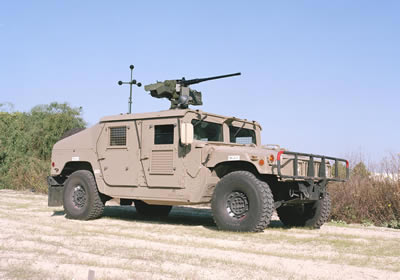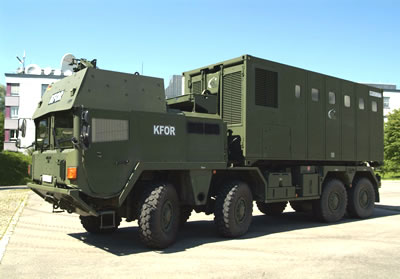Protection of military convoys is becoming a critical issue for military operational planners facing modern guerilla warfare threats. A major concern is the security of the drivers and passengers as well as maintaining the vehicle’s mobility under attack. This is achieved by adding armor to the cabin and engine compartment. Additional measures are provided by active protection means, required when facing RPGs. Convoys are usually secured by heavily armed escort vehicles, which cover the convoy through locations known as high risk areas. These vehicles are armored more heavily than the trucks, and will be the first to be equipped with active countermeasures, used to secure the platform as well as other vehicles from RPG attack.
Typical convoy protectors are Mobile Counter-Fire System vehicles (mentioned above), equipped with acoustic firearms and sniper detection systems, and coupled with stabilized remote operated weapon stations. (The US Army uses the BBN’s Boomerang acoustic detector and SRWS developed by Recon Optical). This integrated sensor-system can instantly return fire in the enemy direction, while on the move. These vehicles are also equipped with electronic countermeasures, to jam radio-controlled improvised explosive devices (IED). These jammers are designed to pre-activate IEDs (by mimicking the command signal) or disrupt the communications channel when the convoy passes nearby. Among the latest jammers currently deployed are the Warlock family of jammers, currently produced for the US Army by EDO Corp. Elisra has developed a wideband RF jammer, which was successfully deployed by the IDF in South Lebanon and the Gaza strip. This jammer covers wide frequency ranges from 20 MHz to 2.5 Ghz and is designed to disable, rather than pre-activate IEDs.
Enemy activity along the road or at specific locations suspected to be ambush points can also be monitored from the air, by unmanned vehicles. While tactical UAVs are tasked primarily with intelligence gathering and are rarely available for such missions, miniature UAVs (MAV) are currently being optimized for such missions. By the application of on-the-move control systems, such MAVs can operate as advanced guard”, securing an area few kilometers to some hundred of meters ahead of the convoy lead element. EO sensors employed by these MAVs can be programmed to detect recent changes in the terrain indicating the existence of an IED or ambush on the roadside. Several MAVs are currently available for such missions, including the ScanEagle, Silver-Fox, Skylark and others.
Additional parts of this article:





















